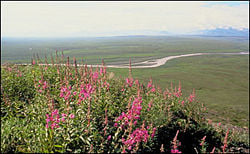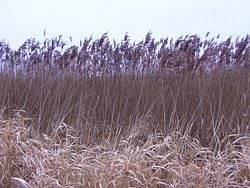Biome
A biome, or "major life zone," is a large geographic region of the earth's surface with distinctive plant and animal communities. There are both terrestrial biomes, such as grasslands and tropical rain forests, and aquatic biomes, such as estuaries.
A biome may also be defined as an extensive ecosystem (ecological unit of living organisms and their abiotic environment) spread over a wide geographic area, or as a grouping of many ecosystems that share similar environmental features and communities (organisms living together in a certain area). Collectively, biomes comprise the biosphere, which is the thin area of the earth's surface where all organisms live.
Biomes are a dynamic, rather than static, entity, and have changed throughout geological history. More recently, biomes have been impacted by human activity. Some of these impacts, such as deforestation, have caused significant environmental challenges. It is important that people understand their local, regional, and global impacts and act responsibly toward the environment, such that future generations can enjoy the integrity and diversity of nature. In biblical terms, this is referred to as the "third blessing," the role of humans to care for all of creation, both the biotic component and the abiotic physical environment.
Biomes represent a superficial and somewhat arbitrary classification of ecosystems. Biologists are not unanimous in how they classify biomes or in the number of biomes. One biologist may classify one particular area as one biome, while another classifies the same region as an ecotone (the area where one biome overlaps another) or as a different biome. In some cases, the word "biome type" is utilized, whereby several biomes are combined into this biome type. For example, the coniferous forest biome type includes the coniferous forest biomes of Europe, Asia, and North America.
Among commonly recognized land biomes are tundra, taiga, temperate deciduous forest, grasslands, deserts, and tropical rain forests, and two major water biomes are those of marine and fresh water. Others add such biomes as temperate rain forests, chaparral, and coniferous forests, and further delineate aquatic biomes into ocean, estuaries, and so forth.
Classification of biomes
It has long been noted that regions of the earth with similar climate tend to have plants and animals with similar adaptations. For example, regions with long, dry periods of little rainfall (deserts) contain plants and animals adapted to these dry conditions. Such plants may flower during the rare periods of rainfall, and tend to be tough, woody shrubs or succulents.
Biomes represent a useful, albeit crude way of classifying ecosystems. Classification of biomes varies and no one system dominates biogeographical studies.
A fundamental classification of biomes is into:
- Terrestrial biomes (or continental biomes) and
- Aquatic biomes.
Four specific classification methods are discussed below.
Typical Classification Scheme
Biomes are most strongly defined by global distributions of vegetation types, which are influenced by global climate, soils, and other physical environment factors. In turn, climate and soil depend partly on latitude, altitude, and terrain factors.
With the exception of deserts and the polar biomes, terrestrial biomes are generally named for the dominant type of vegetation (climax vegetation), such as deciduous forests and coniferous forests.
The following is a common classification of biomes that one might find in introductory textbooks on the topic:
Terrestrial Biomes
Polar Biomes
Arctic and Antarctic regions
Tundra
Northern North America, Europe, and Asia
Coniferous Forest
Northern Hemisphere, south of Tundra
- Taiga (Northernmost band)
- Coniferous belt ("Spruce-moose" belt)
- Southern pine forests
Deciduous forest
Eastern United States, much of Europe, parts of Asia, South America, Africa, and Australia
Grassland
About one-fourth of land surface of the earth
Desert
Extensive areas found on all continents
Chaparral
Mediterranean coast, coast of southern California, southern tip of Africa, and southern coast of Australia
Rain forest
- Tropical rain forest (Found near equator)
- Temperate rain forest (Small relative to tropical rain forest)
Aquatic Biomes
Marine Biome
- Ocean
- Benthic zone
- Pelagic zone
- Neratic Zone
- Oceanic zone
- Intertidal zone
- Estuaries
Freshwater Biome
- Lakes and Ponds
- Rivers and streams
The subcategories of the Marine Biome (Ocean, Intertidal Zones, and Estuaries) are also considered biomes.
Biomes are often given local names. For example, a temperate grassland, savanna, and shrubland biome is known commonly as steppe in central Asia, savanna or veld in southern Africa, prairie in North America, pampa in South America, and outback in Australia.
Latitude Classification
Latitude is a major climate-influencing factor determining biomes. There is a good correlation between the distribution of climates with latitude, and homogenous vegetation bands. Another major factor is humidity. This can be illustrated by the fact that biodiversity increases away from the poles towards the equator, and increases with humidity.
The most widely used classification of biomes is related to latitude (or temperature zoning) and humidity:
Arctic or Subarctic area
- Humid type: Tundra
Subarctic and Boreal area
- Humid type: Taiga or boreal forests
Temperate cold
- Humid type: Temperate broadleaf and mixed forests, temperate coniferous forests
Temperate warm or sub-tropical
- Humid area: Tropical and subtropical moist broadleaf forests
- Semi-humid area: Tropical and subtropical dry broadleaf forests, subtropical coniferous forests
- Semi-arid area: Mediterranean forests, woodlands, and shrub, temperate grasslands, savannas, and shrublands
- Arid area: Temperate deserts and xeric shrublands
Tropical
- Humid area: Tropical moist broadleaf forests (tropical rainforests)
- Semi-humid area: Tropical dry broadleaf forests, tropical coniferous forests
- Semi-arid area: Tropical grasslands, savannas, and shrublands
- Arid area: Deserts and xeric shrublands
Aquatic
- Continental shelf
- Littoral
- Riparian
- Pond
- Coral reef
- Kelp forest
- Pack ice
- Hydrothermal vents
- Cold seeps
- Benthic zone
- Pelagic zone
Altitude and Latitude Classification
Another system of classification takes into account altitude and humidity, ignoring temperature as a factor. This classification is used to define the Global 200 list of ecoregions identified by the World Wildlife Fund (WWF) as priorities for conservation.
This classification gives the following terrestrial biomes:
- Tundra (arctic, humid)
- Boreal forests/taiga (subarctic, humid)
- Temperate coniferous forests (temperate cold, humid to semi-humid)
- Temperate broadleaf and mixed forests (temperate, humid)
- Temperate grasslands, savannas, and shrublands (temperate, semi-arid)
- Mediterranean forests, woodlands, and shrublands (temperate warm, semi-humid to semi-arid with winter rainfall)
- Tropical and subtropical coniferous forests (tropical and subtropical, semi-humid)
- Tropical and subtropical moist broadleaf forests (tropical and subtropical, humid)
- Tropical and subtropical dry broadleaf forests (tropical and subtropical, semi-humid)
- Tropical and subtropical grasslands, savannas, and shrublands (tropical and subtropical, semi-arid)
- Deserts and xeric shrublands (temperate to tropical, arid)
- Mangrove (subtropical and tropical, salt and brackish water inundated)
- Flooded grasslands and savannas (temperate to tropical, fresh water inundated)
- Montane grasslands and shrublands (temperate to tropical, high altitude)
Climate Classification
Climate, simply defined, is the long-term weather of an area. World terrestrial biomes are controlled by climate, and in particular by air temperature and precipitation. The Koppen Climate Classification System is the most widely employed system for classifying the world's climates. This system recognizes five major climate types, based on the annual and monthly averages of temperature and precipitation. For example, Moist Tropical Climates are known for their high temperatures year round and for the large amount of rain year round. Further subgroups distinguish specific seasonal characteristics of temperature and precipitation. The Koppen symbol is presented by a capital letter and small letter system. Using the Koppen Classification system, terrestrial biomes are listed such as Tropical Rainforest (Af), Tropical Rainforest, evergreen forest (Am), Savannah (Aw), Desert (BW), Polar (E), and so forth.
Credits
New World Encyclopedia writers and editors rewrote and completed the Wikipedia article in accordance with New World Encyclopedia standards. This article abides by terms of the Creative Commons CC-by-sa 3.0 License (CC-by-sa), which may be used and disseminated with proper attribution. Credit is due under the terms of this license that can reference both the New World Encyclopedia contributors and the selfless volunteer contributors of the Wikimedia Foundation. To cite this article click here for a list of acceptable citing formats.The history of earlier contributions by wikipedians is accessible to researchers here:
The history of this article since it was imported to New World Encyclopedia:
Note: Some restrictions may apply to use of individual images which are separately licensed.

